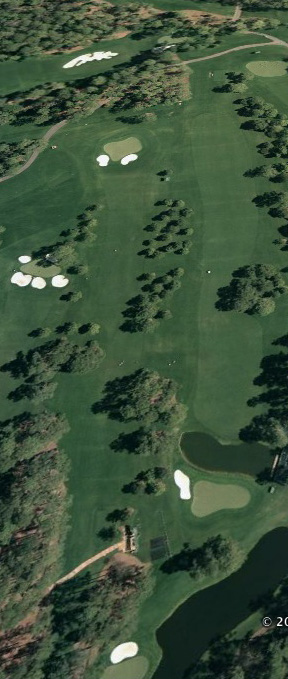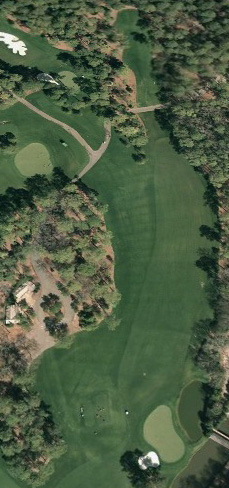That's the closest you're going to get out of me for an April Fool's Day shtick.
 Actually, John Huggan uses his
Actually, John Huggan uses his Scotsman On Yet Another Dreary Sunday Scotland On Sunday column for a nice trashing of the dismal course changes, but with so many new fresh insights thanks mostly to guys named Ogilvy/Ogilvie.
In what is nothing less than a direct and disrespectful contravention of Mackenzie's and Jones' original and delightful philosophy, the Augusta National that will this week host the world's best golfers resembles nothing more than just another one-dimensional country club. Aerial photographs published in the April issue of Golf Digest graphically portray the tragedy that is the modern Augusta National. In place of what were once spacious and tightly cut fairways, rough has been grown and trees have been planted. What was once the most democratic of courses - one that allowed every standard of player to figure out his own way of playing each hole - has become a golfing Zimbabwe, a misguided dictatorship that has all but eliminated freedom of thought and expression.
Ah, we're just warming up.
Where once professionals as diverse as, say, Tom Kite and Seve Ballesteros - the scientist and the artist - could compete on equal terms at Augusta by playing almost every hole in ways that had almost nothing in common, today every player stands on almost every tee attempting to answer the same question and, in turn, hit the same shot.
In other words, virtually every semblance of strategy has been removed.
Today, the paucity of the landing areas, rather than the player, decides how each hole will be played. At Augusta, the spirit of St Andrews is no more.
"I couldn't understand why, at the Masters last year, [former chairman] Hootie Johnson said that he wasn't sure that Augusta National should be fun," says US Open champion Geoff Ogilvy. "That was a very strange thing to say! He is just not right."
Now now Geoff, you forgot. It was all about Hootie. And fun for Hootie was protecting his pride with a high winning score. It's okay, you were a rookie last year.
"Augusta has a lot to answer for, getting the whole world obsessed with really fast greens," contends Ogilvy, who grew up within walking distance of Royal Melbourne. "They have lost a lot of pin positions with that policy. I bet they used to have a lot more variety.
"I would like to see Augusta's greens - even if only for one year - maybe two feet slower. Then they could use some of the front pins that have basically been eliminated. And you wouldn't need the rough. I think everyone would be comfortable with getting rid of it. It's just not necessary. The course is all about the greens. You don't even need the trees. If you put the pin in the right place there is only one good spot on the fairway.
See, that's just way too much to understand for an architect of T...oh we won't go there. Been there, done that.
"I think Augusta is paradise, but the whole golf world tries to follow their lead too much. And all the recent changes certainly haven't been improving the place. I mean, for 60 years not a bad word was said about the place and for the last five a lot of very important people have been very critical. Which is a shame. That course isn't a national treasure, it's a world treasure. It needs to be preserved. And I hope it will be from now on; they'll get it right."
That's a great point, so great I'm going to bring it up again in tomorrow. Why interrupt the fun?
"It's like if you have a beautiful woman, but after her 20th or 30th plastic surgery she doesn't look as good," quips American professional Joe Ogilvie, neatly summing up the feelings of many.
Hmmm...that's a keeper!
Oh, now isn't this fun. Yet another post for tomorrow too.
Most damning is the news that Ogilvy, a big strong boy and a major champion to boot, is seriously considering laying up short and left of the par-3 fourth green, so ridiculously penal does he consider the punishment for even the narrowest miss at this much-lengthened hole.
"I think the 4th is going to be a two-shot hole for me this year," he says. "From short left it is a relatively easy up-and-down; the only pin that is hard is the one way back right. The chip to the front is easy as you can use the slope.
"It's just too risky a tee-shot to go for. If they put the tee where they did last year and the wind gets to swirling, you will see guys hitting it on to the 5th tee or into that stuff on the right. Even the front bunker is not great; it is hard to spin it out of that sand. So the lay-up to the front left is a legitimate play. Even if the ball rolls back a bit it isn't too bad. You can get to every pin except that top right one. So there is a case for it."
Hey, Mike Clayton and I had a blast talking about all of the great long par-3's in golf really become far more interesting as short 4s. Somehow, I don't think that's what Jones and MacKenzie had in mind here. But just think, if Ogilvy plays it like that, then he'll actually get to play No. 6 at Winged Foot as it was intended!
"Two important aspects of modern golf have gone in completely the wrong direction," says the Australian. "Most things are fine. Greens are generally better, for example. But the whole point of the game has been lost.
"Ben Hogan said it best. His thing was that you don't measure a good drive by how far it goes; you analyse its quality by its position relative to the next target. That doesn't exist in golf any more.
"The angle of attack and the shape of the shot mean nothing nowadays. It is 'can you hit it through the goalposts' on every hole. And so the game becomes a one-dimensional test of execution, time after time."
Those humming noises you hear in the background? Both Mackenzie and Jones spinning wildly in their graves.
 A little more fun from the defending champion's sit down. First, the two driver deal:
A little more fun from the defending champion's sit down. First, the two driver deal:
























